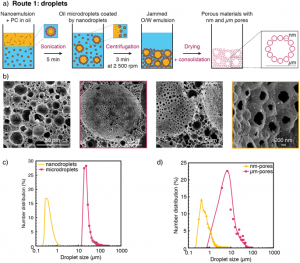Hierarchical porous materials are commonly found in nature and have numerous applications as well, such as catalytic supports, biological scaffolds and lightweight structures. 3D printing has allowed for the fabrication of porous materials in the forms of lattices, cellular structures and foams across multiple length scales. However, according to a group of researchers in a paper entitled “3D printing of sacrificial templates into hierarchical porous materials,” current approaches “do not allow for the fast manufacturing of bulk porous materials featuring pore sizes that span broadly from macroscopic dimensions down to the nanoscale.”
In the research paper, the authors describe how they developed ink formulations to enable 3D printing of hierarchical materials displaying porosity at the nano-, micro- and macro-scales.
“Here, we 3D print inks that consist of nanoemulsions and other microtemplates to produce complex-shaped hierarchical materials with controlled pores ranging from hundreds of nanometers to millimetres in size,” the researchers state. “The pore size of the resulting porous materials can be easily tuned through the selection of the printing path and the size of the pore templating building blocks. Submicron pores are generated from particle-stabilized nanoemulsions, whereas larger droplets or sacrificial polymer particles are used to create pores in a size range varying from 10 to 100 µm. Finally, the macroscopic complex shape and the large-scale cellular architecture of the hierarchical porous material is determined by the 3D printing process.”
The researchers formed stable nanodroplets through a two-step emulsification process. These nanodroplets are stable enough to be concentrated by ultracentrifugation and form a dense jammed template that can be directly converted into a nanoporous structure upon drying or sintering depending on the oil volatility.
“Because the nanoparticles form a dense layer on the surface of the precursor droplets, closed nanopores are often obtained after drying and sintering,” the researchers continue. “However, open pores can also form if the emulsions are slightly destabilized during processing to generate droplet surfaces that are only partially covered by particles. For the emulsions investigated in this work, we found that such slight destabilization is possible by replacing corn oil by decane as the dispersed phase. The ability to tune the process to generate either open or close porosity after sintering enables tailoring of the porous structure according to the properties required by the aimed application.”
 Since the nano- and micro-porosity are generated from the self-assembly of templating droplets and particles within the ink, as opposed to the slow sequential depositing of material, the 3D printing process is simple and fast. Because they are susceptible to coalescence during ink preparation, the templating droplets need to be stabilized by particles that will later form the walls of the pores created upon drying and consolidation.
Since the nano- and micro-porosity are generated from the self-assembly of templating droplets and particles within the ink, as opposed to the slow sequential depositing of material, the 3D printing process is simple and fast. Because they are susceptible to coalescence during ink preparation, the templating droplets need to be stabilized by particles that will later form the walls of the pores created upon drying and consolidation.
“The zwitterionic nature of the surfactant used to promote this stabilization mechanism allows for the use of particles with a variety of distinct chemistries,” the researchers conclude. “Moreover, the dried printed structure can be consolidated either chemically or via heat treatment, depending on the ink formulation. Combined with the complex shaping capabilities of 3D printing, these features make the process highly tunable and open several new possibilities for the design and digital fabrication of hierarchical porous materials for a variety of applications.”
Authors of the paper include Lauriane Alison, Stefano Menasce, Florian Bouville, Elena Tervoort, Iacopo Mattich, Allesandro Ofner and André R. Studart.
Discuss this and other 3D printing topics at 3DPrintBoard.com or share your thoughts below.
Subscribe to Our Email Newsletter
Stay up-to-date on all the latest news from the 3D printing industry and receive information and offers from third party vendors.
Print Services
Upload your 3D Models and get them printed quickly and efficiently.
You May Also Like
3D Printing News Briefs, June 11, 2025: Sustainability, Automotive Tooling, & More
We’re starting with sustainability news in today’s 3D Printing News Briefs, as EOS has strengthened its commitment on climate responsibility, and Zestep is making 3D printing filament out of eyewear...
3D Printing 50 Polymer Stand-In Parts for Tokamaks at the PPPL & Elytt Energy
Of all the world’s things, a tokamak is one of the hardest, most complex, expensive and exacting ones to make. These fusion energy devices make plasma, and use magnets to...
3D Printing News Briefs, May 17, 2025: Color-Changing Materials, Humanoid Robot, & More
We’re covering research innovations in today’s 3D Printing News Briefs! First, Penn Engineering developed 3D printed materials that change color under stress, and UC Berkeley researchers created an open source,...
Firehawk Aerospace Partners with JuggerBot 3D, Gets $1.25M from AFWERX for 3D Printed Propellants
Texas-based Firehawk Aerospace, an advanced energetic materials firm that works with aerospace and defense applications, announced a strategic partnership with JuggerBot 3D, an Ohio-based large-format 3D printer manufacturer. Together, the...



































